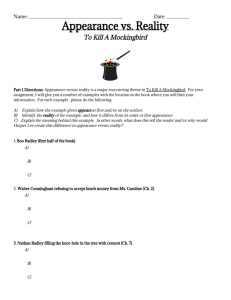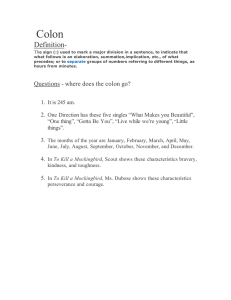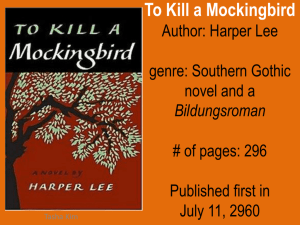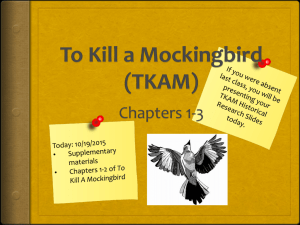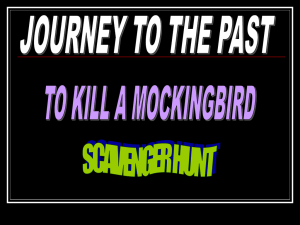NAME: ______________ _
advertisement
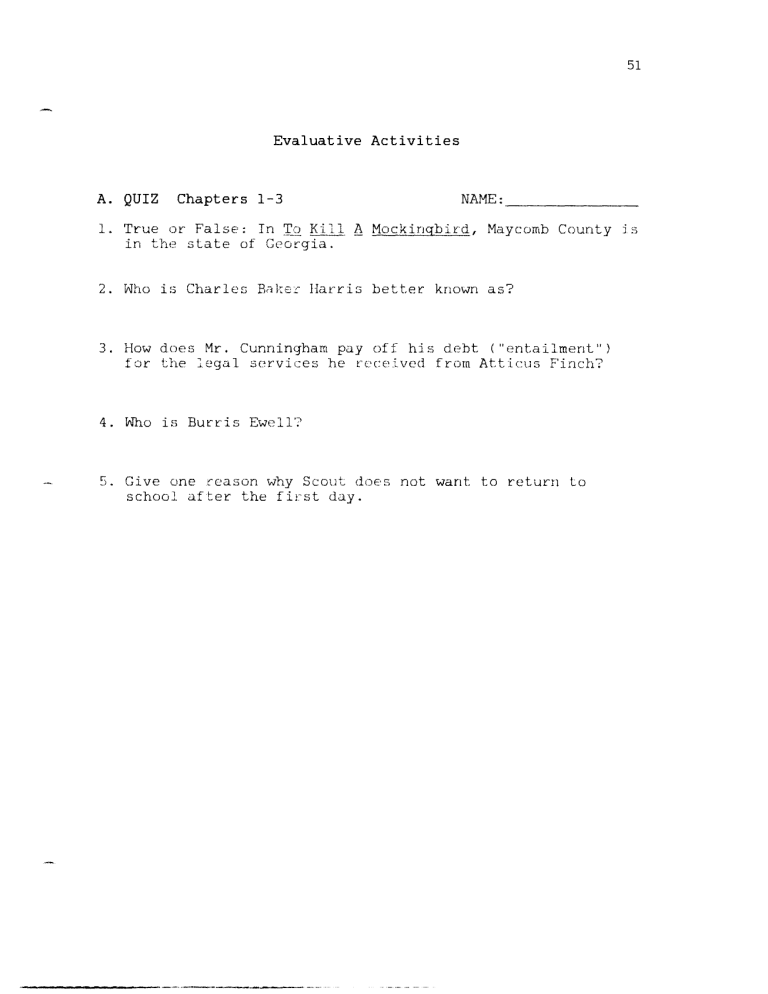
51
Evaluative Activities
A. QUIZ
Chapters 1-3
NAME: _______________
1. True or False: In To Kill A Mockingbird, Maycornb County ]s
in the state of Georgia.
2. Who i:3 Charles Bake:.- Harris better known as?
3. How does Mr.
Cunningham payoff his debt ("entailment")
for the legal services he received from Atticus Finch?
4. Who is Burris Ewell'?
5. Give one reason why Scout does not want to return to
school after the first day.
52
B. QUIZ
NAME: _____________
Chapters 14 and 15
1. True or Fa lse:
Aunt Alexandra wants to
as the Firches' housekeeper and nurse.
di~)mi 55
Calpurnia
2. Briefly dcscr~_be Dill';::; "udvcntur'c" which finally brought
him underneath Scout's bed.
3. A few days before the tria1, what does Heck Tate request
of At t icu~;'?
4. What is Mr. Cunningham's final
entailment question:'
reactiun to Scout's
5. True or False: Atticus is obviously mad at Jem after the
ja:i 1 incident for nClt obeying him becau~3e he rnes~)ag('s hi;j
hair on the way homf~.
53
C. QUIZ
Chapters 23-26
NAME: _____________
1. Briefly describe Jew's feelings about Tom Robinson's
conviction.
2. What sport. would J em 1 ike to g·o out f or next year at
school?
3. True or False: Atticus wants Alexandra to help him inform
Helen Robinson of her husban<l's death.
4. Bow did Mt'. Underwood (the ceLL tor of The Maycomb Tr ibune)
refer to ~:om's deatbir; his cditut:ial?
5. What comment did Bob EwelL make when he heal-d abouL TDm
Robinson's death?
54
D. No Study Required "Quest" over Part One
To Kill ~ Mockingbird
1.
(15 points)
Based on your reading of TQ Kill 12
Mockinqbird 50 far, jescribc how Scout has "changed" or
grown up from the beginning of the novel through chapter
11.
Use TWO ::;pecific example:3 from chapters 1 through 11
to support your ideas.
2. (15 points)
Describe (based on your understanding of the
novel and class discussion) your perception of Atticus
Finch as a father. to Scout and ,hom.
Use a t least TWO
examples from the text to support your answer.
55
E. Heview/Study Guide:
I.
To Kill
~
Mockingbird
Read the entire novel To Kill ~ Mockingbird and know the
main plot, minor story lines, and how they are all
related.
A.
B.
C.
Study your questions/answers from the review
program.
Write a brief (1-2 paragraph) summary of the major
story line. Try not to use the book!
BONUS ACTIVITY: What are your two most favorite
sections of To Kill ~ Mockingbird? Write a short
sta.tement telling why each is a favorite.
II. Know about the characters discussed in class and
"defined" in the "Creative Me" project (if you chose not
to do t~is particular project, there are extra sheets in
the folder marked "CREATIVE ME" -- SHORT OPTION 1).
A.
B.
C.
Know how each character developed throughout the
story (pay particular attention to the Finch family,
the Ewell family, and Tom Robinson). Also know how
each character was influential in the major and
minor story lines.
Who are your two favorite characters in the story?
Write a short description of why they are your
favorites.
Remember in point of view discussion held in class!
III. Know about the main discussion/lecture topics covered in
class.
A.
B.
C.
Make a list of the topics covered (i.e. prejudice,
family life) and write a BRIEF description for each.
Which topic do you feel is the most important in To
Kill ~ Mockingbird? Explain and support your answer
with evidence from the text.
Know about setting and theme, and how they are
Si~Tlificant
(~lements
t.hroughout the entire st.ory.
Good Luck on the Test!
56
F. TEST -- To Kill
I.
~
Mockingbird
Matching:
Place the letter of the correct answer in
the space provided (24 points total).
1. Atticus Finch
2. Walter Cunningham
3. Mr. Avery
4.
Mi~is
Maudie
5. Scout Finch
A. Was embarrassed and
humiliated when in
court.
B. Thought that ch-i Idren
were evil and the ruin
of the neighborhood.
5. Ca=_purnia
C. Thought that Maycomb
families had peculiar
"streaks."
7. Mayella Ewel]
D. Told tales of being
8. Alexandra Finch
9. Dill Harris
10. Helen Robinson
kept prisoner in a
basement.
E. Scout and Jem's
"second" mother and
housekeeper.
11. Jem Finch
F. The modest sharpshooter.
12. Jack Finch
G. A child in Maycomb
who never had his
lunch.
H. A doctor who didn't
like Scout's cussing.
I. A feisty youngster who
didn't like school.
J. A flower -lover whose
house burned down.
K. Often spent time to
himself while growing
up.
L. She slumped to the
ground after hearing
bad news.
57
II. Read the following quotes from To Kill ~ Mockingbir'd.
Place the name of the person that said each quote in the
spaces provided (16 points total).
1
"I know it's February, Miss Eula May, But I know a mad
dog when I see one.
Please, ma'am, hurry!"
2.
"Scout, ... (but) let me tell you something, and don't
you forget it·"
whenever a whi te man [is mean] to a
black man, no matter who he is, or how fine a family
hE comes from, that wl1ite man is trash."
3.
"{file 1 1 , the night
in from the wood
got to the fence
stuck inside th('
4.
"No, :3uh, not after she offered me a nickel the first
I was glCld to do it ... and I knowed she didn't
have no nickels to spare."
______
J.. •
of November twenty-one I was comin'
with a load 0' kindlin' and just as I
I heard Mayella screamin' like a hog
house."
ti.me.
5.
"{fIJe 11, if you don t want me to 9row up talkin'
WCLy, ,,,hy do you send me to school?"
6.
"Grandma, she ci"illed me Cl whore 1 ady and jumped on
me! "
7.
"I wants to know why you bringin' white chillun to a
nj gge: church."
8.
"vJhert:: are you two going at this t lme of day? Playing
hooky, I suppose.
I ' l l just call up the principal and
tell him!"
III.
I
that
Write "" short, yet dotai led paragraph which show whClt
signif icance the following objects had in the stOt"Y (30
points total).
1.
A
~nothole
in a tree:
2. A bottle of coke in a paper bag:
58
3. Old Tim Johnson:
4. A ham costume:
5. A chiffarobe:
6. An old tire:
7. A ripped pair of pants:
8. A dime store baton:
9. A withered, crippled hand:
59
10. A pitcher of molasses at the dinner table:
IV.
Answer all of the following essay questions in a clear,
concise manner (30 points total).
1. Based on what Y:Ju have lear-ned thr-ough reading To Kill
~ Mockingbird, now many different types of prejudice
ar'C' there? Or i.s there one "standard" type of
prejudice that everyone has? Explain your answer-,
citing several 3pecific examples from the text. (10
points)
2. Harper Lee wrott~ To Ki 11 ~ Mockingbird wi th the simple
intent of it be~ng a love story.
How is this novel a
love 3tory? Give and explain the different types of
love that can be found in To Kill ~ Mockingbir_~, and
how each of these types of love effect the eventual
outcome of the story. (10 points)
-------------------
60
3. Compare and/or contrast the characters of AtticU5
Finch and Bob Bwell.
In comparing and/or contrasting
these two characters, cite specific events and
descriptions which focus on their individual abilities
to be good or bad father figures, and discuss how this
effects each man's individual family.
(10 points)
61
G. Grading System:
To Kill
~
~Points for activities in the ro Kill
be totaled as follows:
Mockingbird Unit
~
Mockingbird unit will
Quizzes (2 total) . . . . . . . . . . . . . . . . . . . . . . . . 20
Quest 1 (Computer literacy) .............. 20
QU€~st 2 (TKAMB- Part 1)................. 30
Test over TKAMB . . . . . . . . . . . . . . . . . . . . . . . . . . 100
points
points
points
points
"Creative Me" Projects
(Grade based on work done in class and
if done on word processor) .............. 20 points
20 points
60 points
(20 points per short project, 60 for the long project)
An!3wer s from Program Review.............. 10 points / set
50 points
total
Class Participation
(Role plays, essays, worked
in class, etc.) . . . . . . . . . . . . . . . . . . . . . . . . . 30 points
TOTAL POINTS FOR THE UNIT . . . . . . . . . . . . . . . . . . . . 350 points
Grade Breakdown:
A (100-90%)
~314-280
B (89-80%)
~2'l9-245
C (79-70%)
~244-210
D (69-60%)
~209/below
F (59% and below)
~350-315
62
Rationale:
Daily Lesson Plans
The pur-pose of providin(J
i':l
geneeal overview of this
uni t 's dcci ly 1 esson plans is to give the reader an idea of
how all of the unit activities can be handled and arranged on
a day-to day basis.
Even though the unit is very structured
as a whole,:he individual teacher who chooses to use it can
rearrange act i vi ties,
-Lengthen or shorten acti vi tie s ,
eliminate activities, or even add new activities depending on
hislher need, evaluated class ability, or other unforeseen
factors \>lhich may arise dUY'ing the course of the unit.
The
following outline simp:y tells how the at.thor would teach the
unit, and other teachel-s may usc it straight from the text or
modify it as they so desire.
----------_._--_ _--_.- - ..
..
--
/~ /lMQ tM1,
')1""
C,}i;;
)
di~{.U ~$j Olfftt{ f
?~r!t
3)
,
4)
"
f
a-yt
bo
3)
t'J f
flIA'C7W
,~"
.:
j~ shecfs
.) /
.
,~{,ufzr/YL.~
Va.y 2,
If)
6IV e :5fzutcf~f5
,',itt:. :: r/;'"
r efHtl,N){f' () t
4. Ii/ e.{;;f'[fY1:;;'.
"
pefl vd
re£(d I
I:hk,hn,{)
-
it( r
J) C1. ~ J
",' ( H \
I) T'J I j
l\A.
~:)
(\ f~
c+ v'C y-;. ;
v-p . "
o':":r{ () d.1 ~[.G- '3,;?(C'Y\.
";}'I.< p5 :
I{,' r.:: (e. \ ...
r l?.£Ll
+(11~), fuw t\-u..iJ det/efcp
l~
2.)
' I)
l,tG.
"
i\
I, ",)f
t'Y\. bt(LY l )
D I "2W-.;)<) '. +-<-:p.e<\' c ;
rJ.--p.u \"
ruu-d\
';'>{(C"7
Ll.A.;v),
t.f! t1V[iJ1N~
e~,;.~ ?>~u)
(j, I /,)LG(,~j., t:~
~\
..
.Yl
,L!'
ulL;t/i' iJ'yl ~
J
I
,J'
11'1
C (( ... ~?
~{O iA-fl'
D(~ y( ~lA,y)
'\
({l[L
()1.if
~r
;¥ L'l €¥VI I ('t.£{
Dt
n
,
0/
5)'
•.
I
Gu\(..-J!V j}e..LtlJU"i.
to .:.-'
,~
:/
''';' c:\'--vv'J,'"
vL
,j'Yl
y{
I)
().t.-0 ./)
-11/ \I >,\J:
J
,*(t\\l1c,\,d\f2.
f; ',',,'
" " , ' -I ,
i
\' C
,'c \ tt
(::,11 f 1 "
41"11'1 CJ,L.V\
I""" t
I/e-v e.eL ",\
2- J..£~'i'~
(D
z) 13.e.~iJ'\ ~I \ dGlSS
c;tl '§-(u..~~ bY! O,fev
ee-
-to-e ....."VI.cetD to f
t.tyltLf~ ~ +r>v "?r2A' II-s
ne,~i,.t.bO (::;>
fy
ilque~+"
VtL~ 0.
p I~('LL~';'
YtoM:l.
/ l'1e;'<3\o1!1Ci-
{{({,d'c
e I., ..
t-o
St-cU.td\.t~' P M ~ I
e.)I. pe,;[
(v, L.e'?,
j
3 ) {ib~ ~Y\
C),I S 'i6' _C\
.fo ( ·Oo-'{ l.;
t.f) (l ~~ Gf:1 cJ...:{t- C'.;..'JJ-Y
v i, c~{ ~;..H,LlJ [t~ rj 0 (),
r rI I 1'1'1
_
!(I II (.. ) Pf ( ) .......;, ,; :. ( I ': /' },.,.,vL
, II
t Lt> ~.:..i t: LV
/)'.~~'>(
,
}
dl.'ji[,t~h
j "'(JA
.z.)
-t ,:/' J,r
*'
Cl"
\'
(
'0
)
y '(I ,e~,J .. () d (
/'
'1(1.1
('
+\
L,}CJ..h1 0
j
e~~L'JCJ)
11A74fiI.- (
O~ ~ {Y-' ch ~,
I Z - 13
foy
/)(/...1 10·
Lf)
.
b i ) f:..
of \"c.
[,V 0 (
!L
r t'.-vVl(ll
d. t-eo ( e0-1
or 1 e':;f-;){.1 y
(I 0
(.e({t.f';
I fak t
yt}tv'
1
Of
('{l
At':)
I
•
(:t,
:'lC<;;~'
?it, r~ )
d:
')«'<'~"
~i.-'\-V\' l ire it'-;"1'
r e ([",f i ,)'Y\ 'i> l1. ( P').
(Je,;,{> (:,(\<--h,
DI1
,
t' \A J
.''; \
'f\
,"VI',""
1"'\
~'-. r' ¥1tYl.1 ,ie,.J)
2-) D,::,v d cp cJ I j{.,I.L~h
TI: i (IV 0 I v & ~t>11t?'
p,:.r ';),;y\v..l e,;{ ~e( i ell((:'
L ~,
l....,:l ~f () L.J
"l,) /1
-::J
G Lo.S~
--;'1 ~~11 \
j
{; '(I
cLl;;tJ1).f Sfll clc-ft.f 'C
,,'>'1
~}:.'..1~{ <
Ii,
1_
') Li:
\'1"-1"'" 1£ n..-
I ~ ffL.r~~:'UM";J11
WI fJ -h«Lt1AJ ~ d}1 /:Jo t{.{Iti..
\
~
p(05 rt -:;,-;,
IIt( t,
C(::l~&( L f-{ L'
, '\
ci-\ll{C.l{)f( I it\--+li."r'-- j
~
,f-r1qU-J r
* {\
Pay
2 ')
,
--":I{ :~"'-
qi/?jf?CYW
2»
'.
I~ I,JA'\,..
+\
")
~{ c,M((I..(,k ,";..
In, +\-, e.. (1 ,) re \) ~\ (.1 '/ / vG r. 'i
'
ltei" ,\'\"-pcdt:t¥t- or Itl,U\fC<5;,71
,,~nu t
, C\ V f~ t () J ey
')
:,t-,:L
/-
d. e.veAO\)y,1_L,,/lVt'
-k.h,t'~lz)
~vY\ \'tlt';t
;)1
LJ!V~)
I)V ,'?£ (..L.:';;';'-'
forf\\elt tL,~
r::,rrrufl, DCty1
,
t" --'tl
,-c~
,.
- L- , \
(;{-lt~!-:trYl?:)
At-j.e!, "ct..; ~~-t ,.
~ F'oii"t-C ~VI1E
£' 1-, , f
!I'
01~1I..
I c{ - \:;
( 1 fe·V~'11 t'
:;.
~'(' f) ~1.. Y
ll,
<-f) 61}1[. re..t'l"-:):dJ!?/
[.. ~ pv\l oel tv ~ eoiZ
crvJ or lL-Or1
., c: f(I)XI v' e... v'Vle"
hh<'i "4l"c,1 "
,)
;r
"* 't,
f\-:'7,
CL\j . I •
)~'/A
~"'"
~(r'ULt
_a.:> DtJ.-y ~ I
f,.tUi1 e
0]{tKtf i.
C,
~fY1 t,
U\
I
"
~ ~oi1o iJJ
.:iI (
J
d+t.Jd7J
•
~~'J '+1\1' ~"''k'
Ul.lest·
0-'1\ 'I
L CV\. C"'-V r.i- (\J r-
VV-7 ....),
Lb,)¥-P,
Q,;c";,-+- I) tfCv
\>eA -' ! sv1
ryD to
'
~ (O':1ec\ 1,;-'tv.J./i ";? :r
,u
\
,
..A; kif"
I)
('
(). ~
2 I'~) ().. Y 7
z)~f
,
. 0I'l
',f (u l t 0100
1\ ('
Li) Q..vyvll Ni C{(:If:;'''' in
to (Ill pu.fvy 0{~) 6Y\ 1-<'6
l6mf'
\.1
21 (c-c,<,"e Z,
( c' rIl
~ 10 f,
<!.j/l'LY ttt. +C/f ,
-h NI e, bel.) I
1/'
f
,
+u re;;f...J,
D\
..
:r f
" l ( (J,d-, v'e. II \f
~V\ f ',/:\
~,,",y;t..i¥ tL~
~tud tYI t
fJ) ~~~§<;?iqVl Cfl~, ID-II
, +0
r 1JCLyd (~B') f1me
~;..-
°2'
;1' (eviel"v
II'
L: c1.. 'I
~ bY,
()j)."t{ ;;; ,
lhlrU"
du.I{Lql<"C
0 ()
~) :;~J?? nt,J ,uw-"4f ;.fc) 1)c' (Z.)
f pr
cL v.. t
art"i>
"7'"\/\
toy
1-1.
z)17,":>LLL.'::>S- stvti.t\otr
r (vWd
-rO
.
.,0f"-Lt,
+ \er.LI:9f
sce';''1C?
\'qve-;,..f"
h-V\
"C\lC"J~!'O/CV
Pl (tt.-v" :;i-fl { ( I J
#
'
-K (V \l" (,v .5£l..VVI e. Jor t'f\.J,L.'{
ti... ~ TYA-'{!J ~V 0 Vi' 2,
'J
I ()(l c..iI IVtf lot
j. (LV\ I" uWVl e.. e.
Cj/l!VI-\J' S t::." l \ c.>
1
0.\.-
•
HI (t: ltlhc'Vl/o'io''\\P<~
;), l);?(..uS> "((Wflve.
, IV\("
JV:.J ~ ) hnJ.j,
[,0 htj\ll, J,Li i"l V) 0
Dj'Lts
pH
fr [}--y 3
(,:>'\n)l\v'<:'" d,I')tu'Y)li
+t
r
F'r e II r-1 \ \\'{J...-f Yd. I:') tLt ~~)IL
OYl ;'\ e I (~ L; { r? '
I : CU?(.LtSSic-n
({, '1 -rev l.\. d ~
c d'.v (e It\-ti m
',Y\
1
•
+,!~u"=j
iJ,Jrwp
2)
,grovCf
-0."
:'.>/\cit
t-£'" Clew 11\ -1V!(\
C{ I
tlfl",(Ce.'/
V c', '/ ;:"+.
}"'/ c,· v v I
rc?pty, '0<' '.:> tv '1 v e"-:')
, 1'\(1:U \ po r ttK ,{\ f.,'(IV).
..; ('1 t.-C,,, U Pt:'., (l ~
~,)
f","c,?fUH-'?, dt,
(£) t1551V?1 GlJ~), '-1-7
;aN
5 e./-t. I~,
t¥ ,~(
:'>[l4i..[.(/"J -tv ~'a..,1) ~",:.yv
f1j'
v-.,
1'-1.. cc, \
C.
.. ~ "t";>i>~SVI I·~ud-
I
Pr:!IICl(('
(1-
C:r'
17; e£U- It
5) (:..;v
)(Ct'l ) bi
CLU
.
11 tt-v t:- ~:wU' vl r;>
,I
rt'vl(:U':
/~~.~' ~~( L~{ ~)[\;{,~,
0;'"
,
I
' , kutl e•
I+~
r 1
L
tf't7.
:;(((/1([+
dl [,¥I,
t"w-~)(.!t-u'J
(lf1,.t-l.
I)
~'v(' 1-l--
pt.?,(IOct tv
iP odJY\
jL,
(; 11 w,!",·t!llfA'·),
1>-'
3;) H-a-v't urh {
if) htYe sft(£l(flf~ .,e6f
ol fl,od tZ) it'f1t1 Jefe.
.6) q.66t~ DlI,I'3;;Y
-It; IJe'fJllI
"
L..
Jtb
I) d 1..(.
It. [,L (
:; " l' (", '/ Y. .
''''k~':'V tC111/I
," •
7(" e~fzm ~,
Y' :stud Cttr. f
r
(I).
kc v
Ii ('" ' JI'.bfl
/l
"",,0(
~'1'1 CUll S",-, c,;,' , vt.0
qiJ(<jhcYl ') L r
/~}Mu-kY'j
,
.
r'
Jt')-ht'tUl'.'
ttl" e'jfWYl S"
t.c)
r{L{?>
\1-'/ ~ ( ccrra. WI)
'
t1[.t 117fN lNA.-lutr-/
v.?0y"/~ 5fJ~et5 011 IfpjJ It
Z)
r
2} :;tw;{ t~\ t:;, .z ~pa, ""
d, 1/ ,o.t'd " rt +0
Z. '''.I/O w-p 'S
.,
LcroLLf I' P'·'dLlA.~"5>in\
J;~~oup
re ll.' ev.;. pro 0(tvVYl
in n>
/'
•
leted'1t'J 5) ,ie'f;;, i;1ITO.
oar Sure¥' rr,-Ol--r
,:Jet ht-h ~
.
,,,\
C Ia.SS
r0
1(1
L'Yt~p-u-I-c-(-:;~
\ " DI
I)
iJ{ 2-3,
fJ';Uf')
~ N/I({f d,{-kr' dnlt.
;fy}<jti..'-W
'0
.) ill VI de .::;;twiC.i1. If;
f.
£1 i Vt &,r;f\U/?Y'
v'
0
fr()diL(h~'YL-
I ()
,t..
f\
67 (0 Ll{J
I -:).
;K ~7{) fD ~nH-{)u k~ J.-aJj JOy
Po. 55 tJtd (uui It1-j
a~tt~n ;11 eit- f //~ 1- .
U
I
... CrU!:!, C,>r'f
I) /~S5 ()ut !!~lel'S
;2.)
~p..y $1 Cta.~,; d~" ctet!
L
~. __-- q\O~?
__D'-V. J .
It]trtJ d Ut. 17tf)v 1V
tyro A,~f ' j
r:::,
\.. \.i)
,'t '~
1',
\
"-s--
.
:::
....~\
:;.\' \"
-)
.2:
~
'~
j ~:~
\..}
"
'\., :;-~
-<-L !'"'
i"(
\
\'-
"i
~~
'-...J
',-,
. -....
""-,
--'
--
C'-
.::-
.;;\.\
"-
~,_
~
.-'
\
~:,; ),
----
-S-',
~'
':."'"; ~
~-l,_ f~,
~(:
,
~',-, >
,(""
,~~ ~......
C:
~~\~ (,_._-:~ \1
'--,
~
/F "
~'i
.,
.!
,
\
.:::~>
".
~~
• --.. ,
'!'--....
\ ......,
'",
-
'J...,
....
; )
'-",
>-
(~
(-~
"
r:::
.-J
~'I
('-i,'''},
~ ~3
(' ~
~'-)
\
;0,~j
_ I i <._
'-"" +=
......
r_
-
(1
I
"1'11/ ,,"-,
,~ I.'
'
',', ?-/-
'/~
,.
1l~?7
f
L 1./71
VL7
71 )
)
f'.
_ J,,(fYm,{
, v.,..l lX.){)" L'
ctv
I
'{
r
I
.,', rfuJ
l/),/'O
1/1)
::~.'),L;f
nv,.l. . Yiv11f
"-I-V1-0
I,' "T.T
'J..-/
I
I
V"
/'."
I'"
\AI
vv,
11"0
...y?
1'---
(..
!
1\ ~
'.
I~"V'
vv,,-l ,I~'
v"
III.I\·")/\;;--'.·!
l,U1
~ ,." I { , )'" +
'c,,'-t
>A/)
v.f:',·Yl";~
.. '
.r 7 J
ir?
.II 'J (Y'v1L
I
,. .'
7'
/_!-.. S~,/,·~)
-I1').W·')
d "'7 7 VI'\! ~
\ : ; I _ ~'I
-'
..
I ..J
. '-v-v I (0;1 1 f' tj~7 I V : j ( I
(,....;J, \ vGi
J,.V(!
?/!
f.=--' --------..--- 0..1',,1 I l } 0 ttl
r'
II
,)(f/
?'~/lZ?;JJ)(f
(.17(:1'/ -I-.7.-1II])
*' ...-
I..
,I.
;y-r
1:1(.(\
I)
7
~)d-
,
I
'~7
(Yl?-'
A
I
, l-Z-
f (I
/ ' _, •. / '
:1
,til
I
') I
'1)
.!
! (l
r/
\
[
t; r7 ;:-y,,.w
?
'::..J
":<__'t
I
,
--.:.
'e. (~..l\)(
*:
"t
lA
~"t;<;
(It;) II
.
\,~
. F, \- 1{'l-:1
JO'l
,-)
t
~
lv'
,vj ) (,4.'Y7(' }~/,
~~U GrLJ r1 ('7
oj Iff
(,
~
, lA/I,,); J..':';..rO J-<.J Lt.O
J U.
\-'
}~7
, _ ' v~}(\
(I\.W/;:'
">'10\IOj
..,)
(.
,,~I{I'C!) ~,,",vr-""dV
\ I . ,1\ , . ,
'-.:..
, :1-,,".0.:-,'\'-'
f yl
\.-'_
v)yJ
..V."rvVI )
o,-\.· ('Id
>-,
_>
. ~, ).,~~ -'I
".
-1
j.,' .i- ' "l1'Y'h
~/
I
{
J',,:: \,
. ·nIY'V".:/
"\' Y'1'f}"
:
,
.!
I/O; \
..
-'
--- -'J 0.l..
17 \ \ \
C)~)')·-J /~~~(.
'I'
-\-Y?)
-
w \ I~
, jJ iJ ),/
,
\
'
.:'_
/-t (I
....
U
(-7
\.. <..
,I
.:? a'~1- )1:
(
'
/'
.
''i,n!Yl/}ti':;)
?L
7 1 "c,' 1.+- +. y]l.. !+
("ill )rJ)2r,. ,.7"\( I!
it'-
.
': "(T'
:IL.
'\. to ;) 7' P ~> I
::'( "t')/j)
\
\7 1./'-.'.,
7(\
1..-7 'I
(
{I \ \
'r/(,(!·IA..I-.ji::· )//
.!
c<. n/)--i?
~l"-;..\
.
I (C>
• \"
]7,.[1 (// ;
I
~,. ··V(::
~
'-
!
~\'
[.---d.':'-I-t
,;(,74~ J?C-l·(I
(.~·7 Cr1) ( \.
<. '.r \? ('f' (I II
/\?--+/-rri
-,
:-
-,7/
.')
r )'
fiA1 '1 J- -'\
\.
"-~;;~lJ/rl
1(/ "
'_,
1
(
i
's1v-,c(7 17//1 (7'7, (/77 ) -()) 01 .'j:'
)/.
~~ (fI
~ \ ' \' j- 0
~,<; ....'Y)-;;<i (Z
e
IV/' 3 If:
(7 (Vi
t"'Yd'l'''?j _; 'S
L
L (rWIt/;' :) l, \ 1 • ~
"'r/ /1 r d1,1,1 1
'
.... __
...,
"J1 ,..., ....1~· "-fl r~'
.' J /' I ' C;_.. .' r vi . 7·' /
j
;r
a
:Yl;i' 0-;;>/0
.
, cL-vt{O' 'U,1 ',I
cd.. (I
JYJ..O ~ I I'Z
66
Rationale:
Program Evaluation
The purpose of evaluating the fi.nal SuperPILOT review
program is thr·eefold:
fir-st,
it
i~3
impor-tant that the
program v.;rork!j smoothly, wi thout any flaws;
second, the
program should be useful and attractive to the main category
of user (in this case, the higll school student); and finally,
it should be useful to other teachers in the profession who
may benef i t f rom the actual prog ram, or· who may be interf';:'i t.ed
in writing their own pt-ogram using the SuperPILOT system.
The evaluation technique used was very simple:
the program
was administered to four high school students, two English
teachers (all of the above from Yorktown High School), and
two fellow English education majors at Eal1 State.
They were
asked to run the progri:lm (with aSf, i st:J.flce, if necessary), and
then to c:omnlcnt on it .'.n writi.ng:
first, by using the
provided evaluation fot-m, and secondly, by adding thei.r own
comments.
The following page(s)
include a brief summary of
the commerlts made about the program by those evaluated.
67
Evaluation Comments
Those d.sked to view the program for the most part had
positive co::nments to make about it.
The high school students
felt that it would be useful in helping them understand
difficult sections of the novel, especially the chapters
involving the trial scene (chapters 16-22).
felt that
~he
Only one student
questions on the program were too simple, and
therefore somewhat repetitive to what may be discussed in
class lectures.
This student also felt that the program
could be "j3.zzed up" a little more with some graphics designs
placed after each section (It's a goal I certainly can work
before I use the program in my own classroom!).
The high school teachers asked to review the program
also liked it, with the only real critical comment being that
it may, again, make the novel "too easy" to understand
without reading it.
They really liked the fact that the
students would be given the opportunity to work one-on-one
with some of the more difficult concepts presented in the
program; again, they, too, liked the questions used in the
section of the program involving Tom Robinson's trial.
They
felt that these questions, when combined with some background
discussion on American law and its legal system, and the role
plays included in the unit, would make for a truly
educational experience.
Because of time limitations, I was unable to contact
68
two Ball State colleagues to run and review the program;
therefore, I will take the opportunity to make some of my own
comments on it.
I agree with the student and teacher
comments discussed earlier:
the program does need some color
and "spark" to make it more appealing to the students, since
the program in itself is often repetitive.
And I also agree
that the questions are very simple in places, maybe too
simple.
But hopefully because of this, I will be able to
cater to all academic levels of students in this manner, from
the genius-computer whiz, to the "I-just-want-to-get--by"
student.
The novel
TQ
Kill
~
Mockingbird is indeed a
classic, and definitely a novel to be read, lived, and
understood by all.
Hopefully this review program can help to
not only increase the chances of that happening for the
less-motivated students, but also for those who want to go
beyond the teacher's expectations of merely reading the book
because it was assigned to understanding its relationships to
their everyday lives.
69
Closing Comments
When I first thowJht about doing this project, I never
realized the amount of time, effurt, and patience required to
finish it.
l\lthough i-': seemed Like forever-, I am finally
done, and I definitely learned a lot through the experience.
First, I learned that
education and
u~;e
t_;~)
all
we 11 as create
Cl
is a real need for computer
in a ,1 at"eas of the high school cut"!:_"iculum,
not just in English.
dimens ions
~her~
Cl, T can help the teacher bring new
of act i vi ties and ass ignments, as
k:i.nd~,
new,
CDr):;
t. rur. ti ve f arm of purposefu 1
activity in order to o\:cupy a student's mind and time.
Second, CAl (at least
:n
tJlC English
cla~sroom)
can create
more independence of thought and activity on the part of the
individual s-::;udent; the student is made responsible for what
he/she does or does not do with the unit in question, and the
teacher takes on the true role as an educator and guide in
the process of learning.
Finally, working on such a
p~oject
has helped me to learn more about my own capacities not only
as an cdL,ca tor, but al ;:.0 as a "computer' 1 i tera te" human
being.
I found out that no matter how int imida t ing computerfj
may look, they are definitely more
they are scary
~-
us~ful
and helpful than
frustrating, at timus, but not scary.
Even though time and facilities did not permit use of
the program for all stLdents, the otllCr pl-eceding activities
(including mGiny of the
questjun~;
on the review progt-dm) were
70
used in teacr,ing the unit on To Kill
11
Mockingbird during my
student teaching at Yorktown High School, and were quite
succes sfu1.
For' exampl e, three of the "Crea t i
VE:'
Me"
were used as out-of-class assignments for the unit;
discussion questions, quizzes
I
pt~O
j eets
the
ann Lest over' the novel were
also used in evaluatiwJ individu().l student participation and
understanding. All of the
abov~mentioned
activities achieved
a 65·75% success rate among aU of the sLutlenb:;. Now
including the actual review program with the
unit can assist
in leaving even more time for divergent discussions, in class
project time, and other similar activities.
It is my hope that this project will help others to
learn to go beyond their stereotypical capabilities as basic,
standard secondary educators.
It bas really helped me to
realize my potential in many educati.onal a n.'-' a 5
and most importantly
the realm of CAl.
,
including
Works Cited
n
Apple
fu?BJ& SuperPILOT Edi tor
I
Manual. Cuper'ti_no,
5
California: Apple Computer/Inc.
n
llPEl~
~,e
~!:!perPILOT ~J_angllage
Cupertino, California:
I
1980-82.
Refer-ence Manual.
Apple Computers,
Boyd, Beulah, ed. Huw Do You "Do" ... 7:
Inc., 1980-82.
General Suggestions
and Specific Unib-.. for Secondary ED..9Ji'.5h.
Arizona:
Burns,
Tucson Public Schools, 1962.
Capta~n
Hugh.
'J'ectlnoJ,_~~.
Stimulating Thinking with Computer
Froc. of the Task Force on the Implications
of Educational Technology.
on
Tucson,
Highc~r
Denver:
Colorado Commission
Educati(ln, 16-17 Mar.ch, 19[H.
Christian, Barbara.
Grades 7-12.
Creative Escapes:
Adventures irl Writing
Belmont, California:
Pitman Learning,
1980.
Eisenburs:, J.D. and Bruce Tognazzini.
Pre::~ent:3
... App] e.
Apple
Computet- softwan?
Apr} e COITlp.lter,
Inc., 1982.
Leonardi, Elizabeth B. and Janet L. McDonald.
the English Classt-oom:
Shifting the Emphasis from
Processi.ng Words t.o Processing Ideas."
Te c ltn 01 (2.9Y
Moran,
Charlc~s.
Writing."
27 . 2
"Wol-d
(l
"The Micro in
Educational
98 7): ,1 5 7 .
Pl:-OCP~3:3ing
English Journal
and the Teaching of
72.3 (1983):
113-15.
Rodrigues, Raymond J.
"The Computer'- Based Wr-i t ing Pt-ogram
fr-om Load to Pr-int."
English Jour-nal
73.1 (1984):
27-30.
Schiffman, Shirl S.
"Productivity Tools for the Classroom."
The Computing Teacher
Schwartz, Helen J.
ColI~ Eng 1 ish
Ziegler, Alan.
13.8 (198G):
27·31.
"TE-aching Writing With Computing Aids."
46 . 3 (1984):
2 J 9 -- 4 7 .
The Writing Workshop, vol.
l.
Teachers & Writers Collaborative, 1984.
New York:
Bibliography
"Th<? Heading-Writing Connection:
Anderson-Inman, Lynne.
Classroom Application for the Computer, Par·t 1."
Computirl9'. Teacher
Apple
IT
14.fl (1985): 7.3-6.
Apple Super-PILOT Eci.i tor
Cal ifonlia.:
The
I
f)
ManuaL
Cuper-tino,
Apple Computer', Inc., 1980--82.
Apple l1.. fu2E.:Le SuperPILOT L(3.nguage Reference Manua 1.
CupE'rUno, Califor'nia:
Boyd, Beulah, cd. How
Vo
Apple Computer, Inc., 1980-82.
y(:'~g
"Do" ... ?:
General Suggestions
and Specific Unit:_; for Secolldary English.
Arizona:
Tucson,
Tucson Public Schools, 1962.
Burns, Major Hugh.
"Computing uS a Way of Brainstorming in
English Composition."
Burns, Cuptain Hugh.
Technol(2TI.
E<i.ucation
~~timu1<~:t
Proe,
101.2 (1981):
ing Thinking
~i th
105-08.
Compyter
of the T'.isk For-ce on the Imp1 jcations
of Educational Technology.
Denver:
Color-ado Commission
on Higher Education, 1617 March, 1981.
Catano, '::'amc:3 V.
"Computer'-Based Wri ting:
F1uj,d Text."
CoLl:.~
3 (, . 3 (1 '3 8 5 ) :
309- 1b .
Christian, Barbara.
Grades 7-12.
Navigating the
CQ!!lf29sition and Communication.
Cr-eative Escapes:
Belmont, California:
Adv_entuY'e~~
Pitman Learning,
1980.
Eisenburg, J.D. and Bruce Tognazzini.
in Writing
Apple
Present:3 ... Apple.
Computer software.
Apple Computer,
Inc., 1982.
Harris,
"Student Writers and Word Processing:
Jean(~tte.
Preliminary Evaluation."
Communication
~ollcqc
36.3 (1985):
~Qp1~sitioll
A
and
323 30.
"High Road, Low Road, End of the Road for CAl and
Phi De 1 t~ Kappc.l.n
Progr'amrning?"
Ka.tz, Sandra, and John M. Arones.
Computel
r
"Inquiry:
547 48.
A
Program Based on Hhetol'ical Theory."
Educational Technology.
Lee, Harper'.
68. 7 (1987):
l~
To Kill
25.2 (1985):
Mockingbird.
37-9.
Ph:[ ladelphia:
J. B.
Lippencott, 1960.
Leonardi, Elizabeth B. and Janet L. Mc Donald.
the English Classl-oom:
S'hiftin<J the Emphasis from
Processing Words to Processing
27.2 (1987):
Tcchnol(~gy
Mean~3,
BE'th and Lindy Ll.ndeL
CrcG~tivt~
.I<i~as
amt
McKenzie, Jamieson.
Idea:::~."
Clear and Lively Writ,iJ1t3,:
G,rages 6-10.
Moran, Charles.
Writing."
"AccOl"dion Writing
-- Expository
Enql:i.::;h tJ' cJurnal
56 - flo
"Word Pr'oces5 Lng and the Teaching of
English Journal
72.3 (1983):
Nash, James and Lawrence Schwartz.
the Wri ':' i ng Clas::>."
(19El5):
Englewood,
Unlimited, 1900.
Compos i':' ion wi th the Word Proce::) sor ."
73 .:, (1984):
Educational
45-7.
Activitic~3,
Librar~es
Colorado:
"The Micy'o in
1926.
113 .. 15.
"Making Computet"s Work in
Educational Technology
25.5
"Stimulating CrcativQ Wt'itten
Ro.ime, Ang\? Ie. M.
Through DivercJent Thinking
in Teacher
The Journal of CrQative Behavior
Education."
( 1 9 8 0):
Pr'ocessc~s
Cemmun~ication
14.2
1 2 5- 3 2 .
Rodrigues, Dawn.
"Computers and Basic Wr-iters."
Composition and Communication
Rodrigues, Raymond J.
"'1"1-;,(:
f rum Load to Pt'int."
36.3 (1985):
College
3]G'~.
Computer" Based Wt'i t i n9 Proqram
73.1 (198 /1 ):
Erler 1 i sh cTourn<J.1
27-30.
SchiffmaG, Shirl S.
"Productivity Tools for the Classroom."
The Computing Teacher
Schwart z, He Len ,J.
Solomon, Gwen.
Learning
13.8 (1986):
"Teaching Wri tinq 'Ni th Computer Aids."
"Writing with Computers."
5.3 (1985):
Instruc:: ion."
Electronic
39-43.
Wells, Bethany J. and D. Scott Bell.
Comprehension:
27-31.
"A New Appnlilch tD
Using Cloze o.nd Computer-Assisted
Educationa 1 Technoloqy
20.3 (1980):
49-~;1_
Whitworth, Richard.
C:.a5S Notes (ENG 395/399).
Sept. ·Feb.
1987-88.
Ziegler, Alan.
Teachers
The
Wr:~
& Writers
ting Workshop, vol. 2Collaborative, 1984.
New York:
Appendix
,:
,-
~
-:'"
,-
.
.'..
..,..,
-...,...;- -,
,~.
J.-
....
J
~.-
=
.:,"
..:. ...:.
,-
-
-
--,.,-'
.:.
::.::: 1
-,u,:--
;~
',t"'
,. '-
";
...:;,,-
J~
',.
,
J
-~-:=:T
,=.:.
_,..
i.
._::. ..I..
,:'r"
. '-.i...
.-:-'
1- .:
-.
~
._
......
.(.
:.
-",
.1.:
~
-
-
;~
.-- .
'.r:.""~
',-
.
.
:'.1
-
.- L
-
-
....i_
. .-.t..
.:. ...... -,
...
..!. .-.
r-..
.'r'."--,-,
"Co.
... '".
:~
_
.:.';"
i.. ~
..-"
;
,-
'.
,
•
-.
-
j...
"
...
'
L __
;
-
.1~'
"
..
.
.
i-,"
",
L
l-'
_
.1..
," ' - l .
"T,
.' '-_r--' '':';''
~
-
:',-
'- -
..
''':;'l-,;
"
. -
~
.:
.
~
,-.-:-;
-,
-.... ... 1
:"i... ._...
,~
!..
'T"'-.;
.-."
...... , ,-.""7"'::;.,
::0 -
~
-
:
.....,
1. ... _
-
,
."
,-'
_.
.-.,""',...
'~'''.'
-
.,....,,--,,-,!.: .
...,..-
T
'--.1
~.:.
LC.
_
'"
,..
_
i.,
;:.
-'
:;- '
=
:- ::--, ::
.=
, :
:
,..
"-
.-.
""!
-
-= -
=
-'
~~.
'
j
..:.
1::
.:'"
\0,'
=
:. ::
-c
_, __
i..
- ,7.1 -
. c' '=', . -,-'
!o-•• '
.:?- ........
.:J _ ' .• ' ...
'.,
. . i.
+T,
-- -:-:-
. ,~
-
-,
~-:
-;.
":."
-
:-
:.~"
i."
:::
,-.'--
-.1'::'
."::'
.
. -.\..
. :!. -
~,
-
-
;.
.•
.L
; _
.
. .-.;,...
-;:.. r'
.-
."
.:.
-,-
;1.:
1.'.. .::
..
~
Ii
,- '-
r:' ..
..J -
1,-·'-· -
-
.
:::'"
::. _ 7 .
-
'.t.
_L
,r -
''''.i....:.
'-'L,
:
.'
,::,".1'.
"-
-
.~.::!"'
:
..
=
:: .,;
Evaluation of Unit over To Kill
1.
~
Mockingbird
What is your overall impression of the book, To Kill A
Mockingbird?
2.
What wa:3 your favorite activity in this unit?
Why was it
your favorite?
3.
What was your least favorite activity in this unit?
Why
was it your least favorite?
4.
In reference to the computer review program, did you find
it:
very helpful in allowing me to understand the
novel.
o.k. in helping me understand the novel.
not very helpful at all.
a waste of class time.
5.
What
mi'~ht
be added or deleted from the review program to
make it a better learning tool?
f..
What
wa~~
your favorite pat-t of the entire computer
portion of the unit (including the introductory section
over the Apple computers)?
7.
Please add any other comments about the review program
and/or the unit that you may have in the space below:
Thanks!
Program Evaluation Survey
1.
What is the best feature of this review program?
Why do
you fee1 that it j.s the best?
2.
What is the worst feature of this review program?
Why do
you feel that it is the worst?
3.
What miqht you add to or delete from the program to make
it a more useful learning tool?
4.
Please add any other comments that you would like to make
about the review program in the space below:
Thank you for your time!

